Example Jira implementation
This section describes how multiple Jira defect tracking system server instances can be connected to multiple Helix Core Server instances with P4DTG.
To get the most out of this section we recommend reading the following sections first so you have an overview of how P4DTG works:
Overview
Multiple Jira defect tracking system servers can be connected to multiple Helix Core Servers.
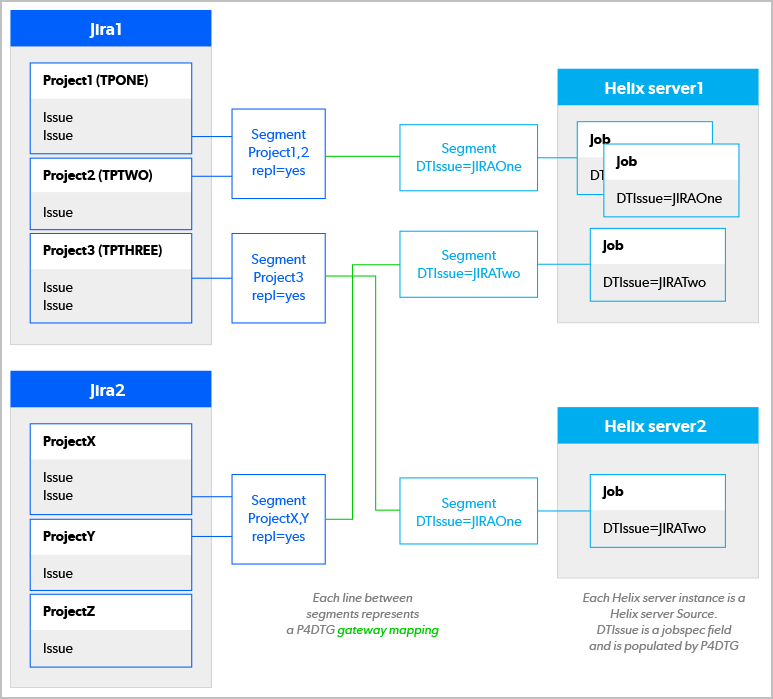
In this example,
- Each Jira instance is a defect tracking source using the *ALL* value for the project
- Jira segments are defined using the Jira '*Project*' field and the Jira custom field repl-yes. Configuration for Sources and Segments (by project) is done with the p4dtg-config. Adding repl-yes is a manual edit.
- Helix Core Server segments are defined using the DTIssue jobspec field. DTIssue is populated when the issue is replicated because of the mapping definition.
- ProjectZ in the Jira2 instance is not replicated
Add replication for your first Jira and Helix Core Server instances
These steps set up projects TPONE and TPTWO from Jira server Jira1 to the Helix Core Server Perforce1.
- Create a global Helix Core Server jobspec:
- Manually define Jira custom fields:
- Identify which defect tracker projects will be mapped to which Helix Core Server:
- Create the first Jira source:
- Add the Defect Tracking source with p4dtg-config b y setting For Project to *All*.
- Jira on premises: enter your Jira URL, the P4DTG user, and P4DTG user password.
- Jira Cloud: enter your Jira Cloud URL, your user email, and your user Atlassian API token.
- Edit the attributes of this source so that:
- Workflow and field definitions points to the name of your jira-rest-config.xml file from Step 2
- Allow Jira issue creation is set to n
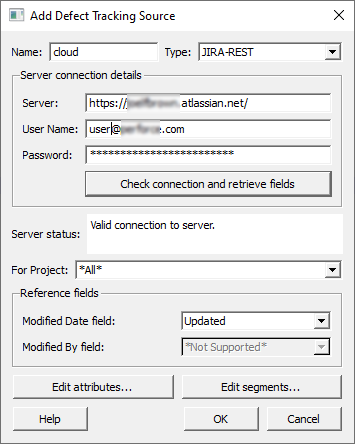
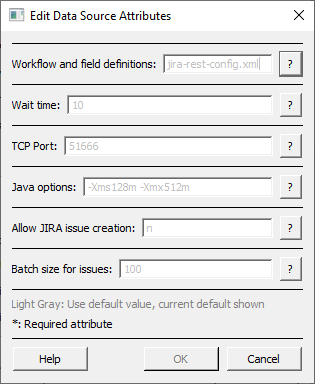
- Create Jira Segment for current Helix Core Server:
- Create the Helix Core Server source and edit the attributes of this source:
- Create a Helix Core Server segment:
- Create your mapping:
Construct a jobspec containing all the Jira fields you want to replicate. The jobspec must contain a DTInstance select field that lists each Jira defect tracking system instance name. This instance name can be any value that identifies the instance. For example: JiraOne, JiraTwo.
Every Helix Core Server instance should have this same jobspec. For an example, see Example - JobSpec.
Define Custom fields using the jira-rest-config.xml file as a starting point. For an example, see Example - extract of jira-rest-config.xml for Jira Custom Fields.
Make a note of the definition of the ReplicateToPerforce SELECT field because we will use this as a second field for segmenting.
For each Defect Tracking server instance, identify the projects to replicate, and for each project identify the target Helix Core Server instance for replication.
For the Jira source, Edit Segments and create a new segment from the *Project* SELECT field. Select all projects to be replicated to one Helix Core Server instance.
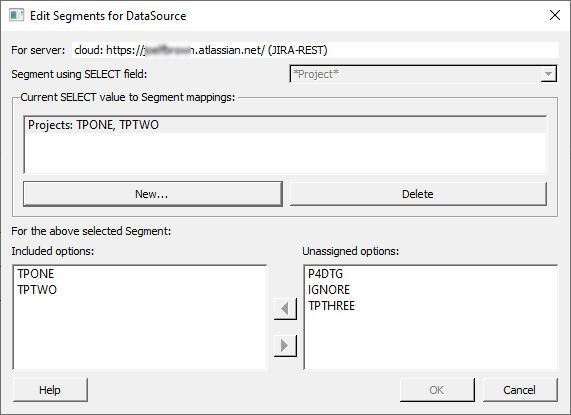
Set Generate job ids to y to create Helix Core Server jobs in the format <JiraIssueName>-<mapName>.
Specify whether it is a Unicode server or not.
If it is not a Unicode server, specify a character set, and set Replace missing character set mappings to y.
For non Unicode Helix Core Servers, you can provide a character set for translation of the Jira UTF8 text. If you do not know which character set is required, we suggest you use winsansi.
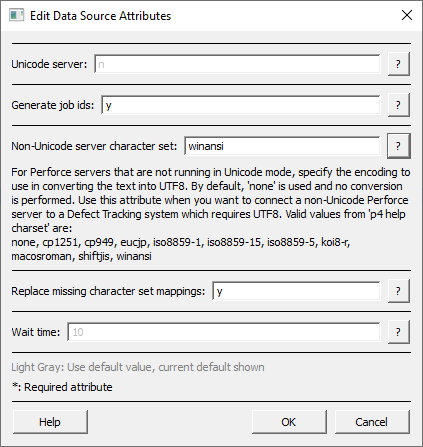
For the Helix Core Server source, Edit segments and create a new segment from the DTInstance SELECT field and select the value representing the corresponding Jira instance for this Helix Core Server.

Map the Defect Tracking source segment you created previously to the Helix Core Server source segment. Copy fields as required (summary, description, etc.).
Copy the Jira source *Project* field to the Helix Core Server DTInstance field and map all Project Values to the DTInstance value. You should see only one DTInstance value because of the segment definition you created in Step 7.
Although you must map all of the Project Values, only those within the Jira segment definition from Step 5 will be used.
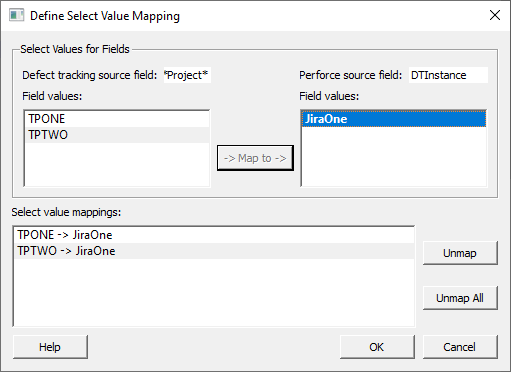
Add a new defect tracker or Helix Core Server
When mapping additional defect tracker or Helix Core Server sources:
- If the Jira projects are in an existing source, just add a segment specifying the projects using Step 5 in the previous section (Step 4 is not needed).
- If the Jira projects are not in an existing source, create a new source and segment.
- If the Helix Core Server has an existing source, just add a segment specifying the DTInstance using Step 7 in the previous section (Step 5 not needed).
- If the Helix Core Server does not have an existing source, create a new source and segment.
Segment on two fields (after p4dtg-config)
When this change has been made, it is important that you do not edit the source from p4dtg-config again. If the source is edited, the changes will need to be applied to the file again.
To segment on two fields, manually edit the config files.
Edit the src-<source_name>.xml file in the config directory. In the <FilterSet> element of the appropriate segment, add another <FilterRule> for the additional field and pattern.
Example for segment jira-scm1.xml:
<FilterSets>
<FilterSet
name="jira-scm1">
<FilterRules>
<FilterRule
field="*Project*"
pattern="TPONE" />
<FilterRule
field="*Project*"
pattern="TPTWO" />
<FilterRule
field="ReplicateToPerforce"
pattern="Yes" />
</FilterRules>
Replicate a new Project (after p4dtg-config)
Because you have manually edited the Defect Tracking source config files, edit the config file manually. Do not edit the Defect Tracking Source within p4dtg-config. If the source is edited, the changes will need to be applied to the file again.
After initial setup, you can add additional projects and replicate them.
To replicate a new project:
- Stop replication for the source and mapping you want to edit.
- Edit the src file applicable to the defect tracking instance hosting the project to add a new <filterRule> with field="*Project*" and pattern="<newProjectName>".
- Edit the map file applicable to this defect tracking instance. Add the new project to the application's '*Project*' <CopyMap> element list.
Status mirroring, from Helix Core Server back to Jira
If a mirrored field is updated in the same replication interval, the defect tracker value will overwrite the job value, possibly losing data.
Unless all of your projects use the identical workflow, status mirroring is not supported. This is because of the large number of workflows you would have to describe and maintain.
The recommended method is to copy the Helix Core Server job status back to another Jira custom field. In the future, you can implement functionality on the Jira side to detect the Helix Core Server job status change and alter the Jira status appropriately.
Additional notes on creating and editing Helix Core Server Jobs
The Generate Job Ids attribute creates the Helix Core Server job name to match the Jira name using the format <JiraIssueName>-<mapName>. To use a different naming convention by using a form-in job trigger, see Example form-in job trigger.
Users can continue to create Helix Core Server jobs if a mapping is in place. However, even if the user sets the DTInstance field to force replication, a Jira issue will not be created. This is because the Jira source attribute Allow jira issue creation is set to no.
Example configuration files
While the syntax of these examples is correct, the examples include some values that cannot work. Adjust the configuration for your P4DTG installation before attempting to use these examples in testing or production.
Example - JobSpec
# A Perforce Spec Specification.
#
Fields:
101 Job word 32 required
102 Status select 10 required
103 DetectedBy word 32 required
104 DetectedOn date 20 required
105 Description text 0 required
106 JiraStatus word 10 optional
115 Summary line 60 required
110 ModifiedBy word 32 always
111 ModifiedOn date 30 always
112 Type select 12 required
113 AssignedTo word 32 optional
114 Priority select 10 optional
116 Comments text 0 optional
120 EstimatedFixTime line 0 optional
122 PlannedClosingVersion line 0 optional
124 CurrentEffort line 0 optional
146 DTG_FIXES text 0 optional
147 DTG_DTISSUE word 32 optional
148 DTG_ERROR text 0 optional
149 DTG_MAPID word 32 optional
130 DTInstance select 10 required
Values:
Status Open/InProgress/Reopened/Resolved/Closed
Type NewFeature/Task/Improvement/Bug/Sub-task
Priority Major/Minor/Critical/Trivial/Blocker
DTInstance JiraOne/JiraTwo/None
Presets:
Status Open,fix/Closed
DetectedBy $user
DetectedOn $now
Description $blank
Summary $blank
ModifiedBy $user
ModifiedOn $now
Type Bug
DTInstance None
Example - extract of jira-rest-config.xml for Jira Custom Fields
<CustomFields>
<CustomField name="Status From Perforce" type="LINE" access="RW" />
<CustomField name="Current Effort" type="LINE" access="RO" />
<CustomField name="Test Custom Field Date" type="DATE" access="RO" />
<CustomField name="ReplicateToPerforce" type="SELECT" access="RW">
<Option value="Yes" />
<Option value="No" />
</CustomField>
</CustomFields>
Example - Jira Rest source xml config files
<?xml version="1.0" ?>
<DTGConfiguration
version="1"
updated="2011/05/16 14:27:32 UTC">
<DataSource
type="DTS"
plugin="JIRA-REST"
nickname="Jira"
server="https://my-company-jira.atlassian.com"
user="[email protected]"
epassword="####"
module="*All*"
moddate_field="Updated"
moduser_field="*Not Supported*">
<FilterSets>
<FilterSet
name="jira-scm1">
<FilterRules>
<FilterRule
field="*Project*"
pattern="TPONE" />
<FilterRule
field="*Project*"
pattern="TPTWO" />
<FilterRule
field="ReplicateToPerforce"
pattern="Yes" />
</FilterRules>
</FilterSet>
</FilterSets>
</DataSource>
</DTGConfiguration>
Example - Perforce source xml config file
<?xml version="1.0" ?>
<DTGConfiguration
version="1"
updated="2011/05/17 14:11:33 UTC">
<DataSource
type="SCM"
plugin="Perforce Jobs"
nickname="P4"
server="20124"
user="p4dtg"
epassword="###"
module="Jobs"
moddate_field="ModifiedOn"
moduser_field="ModifiedBy">
<Attributes>
<DataAttr
name="sub_missing"
value="y" />
<DataAttr
name="gen_jobname"
value="y" />
</Attributes>
<FilterSets>
<FilterSet
name="Instance1">
<FilterRules>
<FilterRule
field="DTInstance"
pattern="JiraOne" />
</FilterRules>
</FilterSet>
<FilterSet
name="Instance2">
<FilterRules>
<FilterRule
field="DTInstance"
pattern="JiraTwo" />
</FilterRules>
</FilterSet>
</FilterSets>
</DataSource>
</DTGConfiguration>
Example - mapping xml config file
<?xml version="1.0" ?>
<DTGConfiguration
version="1"
updated="2011/05/16 14:32:28 UTC">
<DataMapping
id="P4toJira"
scm_id="P4"
scm_filter="Instance1"
dts_id="Jira"
dts_filter="jira-scm1"
mirror_conflicts="ERROR">
<FixRule
dts_field="Fix"
copy_type="APPEND"
file_list="1"
change_number="1"
description="1"
fixed_by="1"
fixed_date="1" />
<ScmToDtsRules>
<CopyRule
scm_field="Status"
dts_field="Status From Perforce"
copy_type="LINE"
truncate="0" />
</ScmToDtsRules>
<DtsToScmRules>
<CopyRule
scm_field="AssignedTo"
dts_field="Assignee"
copy_type="WORD"
truncate="0" />
<CopyRule
scm_field="DetectedBy"
dts_field="Reporter"
copy_type="WORD"
truncate="0" />
<CopyRule
scm_field="JiraStatus"
dts_field="Status"
copy_type="WORD"
truncate="0" />
<CopyRule
scm_field="Comments"
dts_field="Comments"
copy_type="TEXT"
truncate="0" />
<CopyRule
scm_field="Summary"
dts_field="Summary"
copy_type="LINE"
truncate="0" />
<CopyRule
scm_field="Description"
dts_field="Description"
copy_type="TEXT"
truncate="0" />
<CopyRule
scm_field="DTInstance"
dts_field="*Project*"
copy_type="MAP"
truncate="0">
<CopyMap
value1="TPTWO"
value2="JiraOne" />
<CopyMap
value1="TPONE"
value2="JiraOne" />
</CopyRule>
</DtsToScmRules>
</DataMapping>
</DTGConfiguration>






